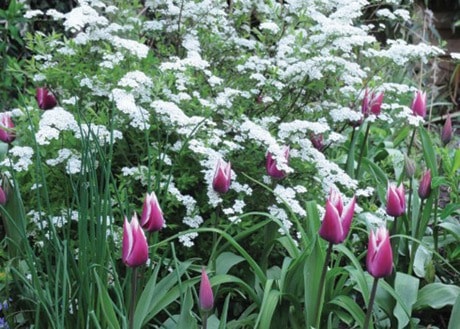Each spring, a great many gardeners are upset with withering daffodil and tulip leaves that looked unsightly for such a long period of time.
What really worries me, however, are the numerous comments folks have made about not planting bulbs because of their sloppy foliage that can spoil the appearance of an otherwise neat and tidy garden.
It would be a shame for any garden to lose these vibrant spring colours, simply because of a few leaves, when there are many ways to overcome the problem.
The most obvious solution is to group bulb plantings in pockets where they can make their wonderful display and then die back without disrupting the entire garden.
If you can camouflage them among other plants, so much the better.
Secondly, by adding copious amounts of sand when you plant the bulbs, they will not only naturalize more easily, but will also die back more quickly.
The most creative and effective way to enhance a display of spring bulbs is to plant them in combination with shrubs. With a little imagination, you can come up with great combinations that give your garden a new look, conceal dying foliage and make certain locations work overtime to keep that colour coming.
Flowering shrubs are a natural for companion planting with bulbs. I’ve often mentioned the combination of miniature blue Iris reticulata with the ‘Buttercup’ winter hazel (Corylopsis pauciflora), but also try fragrant Daphne mezereum with the crocus ‘Remembrance’. The lavender tones work magic together.
Winter heather is a natural for bulb combinations because it flowers from November until late April, and then it flushes out with lots of new growth to screen bulb foliage. Try combining it with some miniature narcissus, like ‘Minnow’, ‘Hawera’ and ‘Jack Snipe’. Early blooming ‘Star Magnolias’ (Magnolia stellata) could be greatly enhanced with an underplanting of white narcissus like ‘Ice Follies’. When the leaves flush out on the magnolia, they would nicely conceal the narcissus leaves.
Larger magnolias should not be left out, either. ‘Saucer Magnolias’ (M. soulangiana), that often lose their big blossoms prematurely due to heavy spring winds or rains, would be greatly enhanced by an underplanting of beautiful salmon ‘Angelique’ tulips.
Flowering quince looks spectacular in any spring garden, but a surrounding planting of early double tulips would be a real classy touch. Try ‘Peach Blossom’ around the whites and pinks and the yellow ‘Monte Carlo’ around the orange and scarlet varieties.
White spiraeas offer all sorts of opportunities with red tulips. Spiraea thunbergii would be a knockout with the early tulip, ‘Red Emperor’. The mid-season ‘Snow Mound’ (S. nipponica tosaensis) would look great with red ‘Darwin’ tulips, and the late-flowering ‘Bridal Wreath’ spirea (S. arquta) would be nice combined with a red lily-flowering tulip. Spiraeas are great for covering up tulip foliage.
Don’t forget about broad-leafed plants, either. One of the most overlooked sun- or shade-loving plants is the ‘Oregon Grape’ (Mahonia aquifolium). Its yellow flowers and green holly-like foliage would combine beautifully with the soft yellow narcissus ‘Carlton’. Euonymus ‘Emerald n’ Gold’ and white/green ‘Gaiety’ provide a wonderful opportunity for tulip planting. Bright coloured early single or trumpet tulips could be underplanted for a delightful effect each spring. If the new growth was left untrimmed, it would cover dying tulip foliage, and then both could be pruned at once to save time.
Long-blooming, low-growing shrubs like potentillas and dwarf spiraeas offer tremendous potential for daffodil and tulip plantings. The red, white, orange and pink blossoms that begin in late April can provide a neat contrast for late flowering varieties of bulbs, or the green foliage can offer a backdrop, then cover for the flowers and leaves.
Hostas and ferns also provide good foliage cover for daffodil and tulip leaves in areas with morning or dappled sunshine.
Frankly, the potential for fabulous combinations is unlimited. This fall, take a new look at the opportunities for using your tulip and narcissus bulbs to enhance your existing trees and shrubs. In doing so, you not only create a new dimension in colour schemes, you can also conceal the foliage that too often can spoil the fresh look of your spring gardens.
Brian Minter owns and operates Minter Gardens just outside of Chilliwack.
